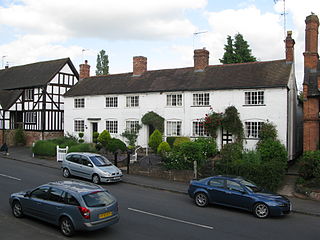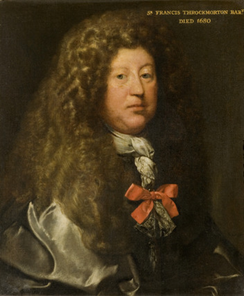
Baddesley Clinton is a moated manor house, about 8 miles (13 km) north-west of the town of Warwick, in the village of Baddesley Clinton, Warwickshire, England. The house probably originated in the 13th century, when large areas of the Forest of Arden were cleared for farmland. The site is a Scheduled Ancient Monument and the house is a Grade I listed building. The house, park and gardens are owned by the National Trust and open to the public; they lie in a civil parish of the same name.
A priest hole is a hiding place for a priest built in England or Wales during the period when Catholics were persecuted by law. Following the accession of Queen Elizabeth I to the throne in 1558, there were several Catholic plots designed to remove her, and severe measures, including torture and execution, were taken against Catholic priests. From the mid-1570s, hides were built into houses to conceal priests from priest hunters. Most of the hides that survive today are in country manor houses, but there is much documentary evidence, for example in the Autobiography and Narrative of the Gunpowder Plot of John Gerard, of hides in towns and cities, especially in London.

Sir Thomas Tresham was a prominent recusant Catholic landowner in Elizabethan Northamptonshire. He died two years after the accession of James VI and I.
Sir Francis Englefield was an English courtier and Roman Catholic exile.

Chaddesley Corbett is a village and civil parish in the Wyre Forest District of Worcestershire, England. The Anglican and secular versions of the parish include other named neighbourhoods, once farmsteads or milling places: Bluntington, Brockencote, Mustow Green, Cakebole, Outwood, Harvington, and Drayton.

Coughton Court is an English Tudor country house, situated on the main road between Studley and Alcester in Warwickshire. It is a Grade I listed building.

Nicholas Owen, S.J., was an English Jesuit lay brother who was the principal builder of priest holes during the reigns of Queen Elizabeth I and James I of England. Owen built many priest holes in the buildings of English Catholics from 1588 until his final arrest in 1606, when he was tortured to death by prison authorities in the Tower of London. Owen is honoured as a martyr by the Catholic Church and was canonized by Pope Paul VI in 1970.

There have been two baronetcies created for different branches of the Throckmorton family, 6th cousins, both descended from Sir John Throckmorton, Under-Treasurer of England temp. King Henry VI (1422–1461). Both titles, which were in the Baronetage of England, are now extinct. The Throckmortons, originally of Throckmorton near Pershore, Worcestershire, trace their history back to the 12th century. In 1409 Sir John de Throckmorton, Under-Treasurer of England, married Eleanor Spinney, daughter and heiress of Guy Spinney of Coughton, Warwickshire, where the senior branch of the family, which bore the junior baronetcy, became established. The Coughton estate included in 1968 a dower house named "Spiney House, Coughton", named after that family. The senior Throckmorton Baronetcy, of Tortworth in the County of Gloucester, was created in the Baronetage of England on 29 June 1611 for William Throckmorton, of Coss Court, Tortworth, Gloucestershire, sixth in descent from John Throckmorton, younger son of Sir John Throckmorton, Under-Treasurer of England. The third Baronet sat as Member of Parliament for Gloucestershire and Wotton Basset. The title became extinct on the death of the fourth Baronet in a duel in 1682.

Sir John Lyttelton was an English nobleman, politician, knight, and landowner from the Lyttelton family during the Tudor period.

Sir George Throckmorton of Coughton Court in Warwickshire, England, was a Member of Parliament during the reign of King Henry VIII.

Sir Robert Throckmorton, KG, of Coughton Court in Warwickshire, was a Member of Parliament and a distinguished English courtier. His public career was impeded by remaining a Roman Catholic.

Sir Robert George Throckmorton, 8th Baronet was an English Whig and Liberal politician who sat in the House of Commons from 1831 to 1835.

Sir Henry Bromley was an English landowner and politician who sat in the House of Commons at various times between 1584 and 1604. He was twice imprisoned for his political activities, the second and most serious occasion in the aftermath of the Essex Rebellion. Restored to favour in the Jacobean period, he was vigorous in suppressing the Gunpowder Plot.

Sir Francis Throckmorton, 2nd Baronet (1641–1680), of Coughton Court, Warwickshire and Weston Underwood, Buckinghamshire, was a member of a prominent English family of Roman Catholic dissenters.

Sir Thomas Giffard was a Tudor courtier, Staffordshire landowner and Member of the English Parliament.

St Peter and St Paul and St Elizabeth Catholic Church is a Catholic church built between 1851 and 1853 by the Throckmorton family in the grounds of their family home, Coughton Court. The church was commissioned by Sir Robert Throckmorton, 8th Baronet, in the years after the Catholic Emancipation Acts which would re-allow the profession of the Catholic faith officially for the first time since the Tudor period. The church currently holds Grade II listed status.

Sir Robert Throckmorton, 4th Baronet, was a member of a prominent English family of Roman Catholic dissenters.

Sir Charles Yate, 3rd Baronet was an English landowner.
Mary Habington or Abington, néeParker was an English recusant. Antiquarian writers thought that she was the author of the anonymous letter to her brother William Parker, 4th Baron Monteagle which warned of the Gunpowder Plot. This theory is dismissed by modern historians. She sheltered a number of Catholic priests and recusants at her Worcestershire home Hindlip Hall.

















